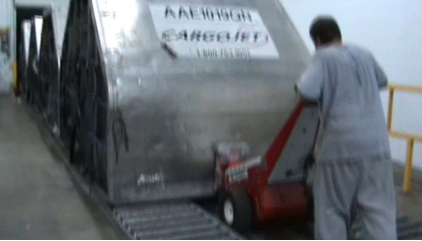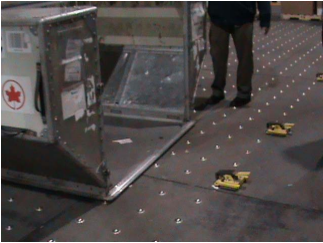Concern details
Task description:
Packages that are transported by airplanes are first loaded into air cans. The air cans have to be moved from the courier depot to the airplanes at the airport. The air cans are very heavy when full and require excessive for to move them even if they are on rollers. It takes 4-7 workers working together to manually move the air cans on the rollers (Figure 1).

Figure 1: pushing air can
Evaluation:
Moving air cans into trailers requires an excessively high push which was not possible to quantify the force because it exceeded the maximum threshold of the force gauge (113 kg). The required force exceeds the strength capabilities of males and females [1] as well as the maximum acceptable push force of 27 kg [2]. In addition, based on the analysis with a biomechanical human model (3D SPSS), the majority of the population does not have appropriate strength to push the air cans. Manually pushing the air cans results in increased risk of injury. Furthermore, tripping hazards are also cause for concern when the workers push the air cans over the rollers.
Countermeasures
The following countermeasures are recommended to reduce the risk of injury to the workforce when moving the air cans:
- Implement power pusher to eliminate risk of manually pushing the air cans (Figure 2). It may also be necessary to add emery tape smooth floor to improve the traction.
- Install roller ball floors to move the air cans on.

Figure 2: Power pusher moving air can

Figure 3: Roller ball floor
References
- Department of Trade and Industry (DTI). (2000). Strength Data for design safety – Phase 1, Government and Consumer Safety Research, London.
- Snook, S.H. and Cirello, V.M. (1991). “The design of manual handling tasks: Revised tables for maximum acceptable weights and forces.” Ergonomics 34(9): 1197-1213.